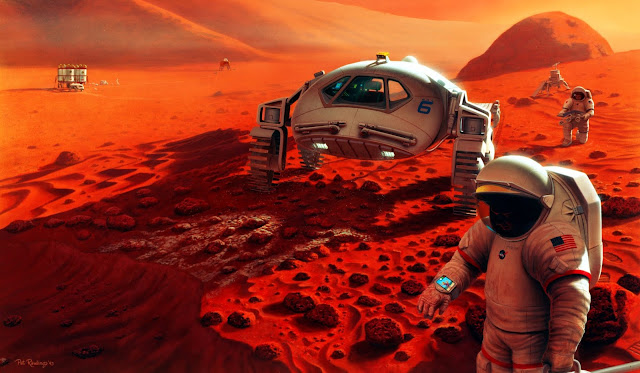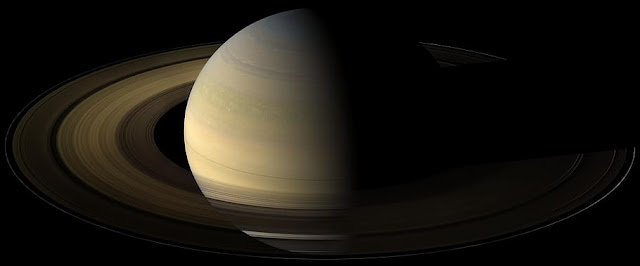How Long Could You Survive on Each Planet ?
Thoughts on the colonization of the moon and planets of the solar system have long fascinated people. At first it was just science fiction writers but the more science develops the higher the likelihood that colonization will one day happen. Someday people will live outside the earth. However, well this is a very tempting prospect life on other planets is full of dangers and I'm not talking about possible diseases or even a hypothetical attack from highly secretive aliens. A person's survival outside the Earth's atmosphere largely depends on how well their spacesuit would work but there are many ways this important piece of equipment can break down.
 |
| How Long Could You Survive on Each Planet Without a Spacesuit? |
For example, the cooling system could fail and then the helmet would begin to fill with water. A similarly terrible story happened with the italian luca parmitano when the astronaut was in outer space.
When water suddenly appeared in his helmet covering his eyes ears and nose in order not to drown parmitano was forced to urgently return to the ISS. In addition, a spacesuit could become deep pressurized at the most unfortunate moment and its electronic components, communication device, and air supply could fail.
There are simply too many potential emergency situations involving protective spacesuit. So, what would happen to a person if they completely deprived themselves of a spacesuit outside earth say on another planet?
A little spoiler nothing good to begin with it's worth noting that outer space can kill a person without a special suit in about 90 seconds. At first, the pressure difference would cause the body to expand not so much that it bursts but to compress the blood vessels, water would quickly begin evaporating from all surfaces of the body including the eyes and tongue, without air in the lungs blood would stop delivering oxygen to the brain, after about 15 seconds you would pass out and then suffocation would do the rest, not a very pleasant scenario.
On the Surface of Mercury
 |
| Surface of Mercury |
But let's get to the surface of mercury the planet closest to the Sun. Mercury is the smallest planet in the solar system. Its surface resembles that of the moon and temperatures range from -173 to +427 Celsius or -279 to +801 Fahrenheit.
The atmosphere of mercury is quite weak and contains hydrogen, helium, oxygen sodium, calcium potassium, and water vapors. It's simply impossible to breathe air without a spacesuit but this isn't the only problem., The side of Mercury facing the Sun is very hot while the other side at the same time is incredibly cold depending on where a person is he would either be fried or turned into ice and only if this unfortunate person could find some kind of intermediate zone where they would constantly and quickly rotate, could we talk about survival but only for 90 seconds as in outer space.
On the Surface of Venus
 |
| Surface of Venus |
Some scientists are seriously discussing the terraforming of Venus. They believe that technology could change the planet so that Venus would become suitable for colonization, meaning to return water to its surface to correct the climate. It's no coincidence that Venus is called the sister of the earth. It's about the same size and mass and also has similar gravity but all of this doesn't necessarily mean that you could walk there without a spacesuit. Venus is the hottest planet in the solar system with an average surface temperature of 462 degrees Celsius that's 864 Fahrenheit.
Its Local atmosphere is 96% carbon dioxide so there's no question of any breathing, death would occur even faster than on Mercury in less than one second a person would simply turn to dust.
On the Surface of Mars
 |
| Surface of Mars |
Colonization of Mars has recently been talked about more and more often the red planet looks highly attractive as a future place to live. The day there is comparable to ours here on earth. There's water and in theory may be suitable for growing potatoes so, what else is needed for life. It's possible to survive on Mars outside of a space base without a spacesuit for only a short period of time. It has a very thin atmosphere with 95% carbon dioxide plus low atmospheric pressure an average of 160 times less than Earth's, add to this its temperature range from -143 Celsius that's -225 Fahrenheit at night at its poles to 35 degrees Celsius or 95 Fahrenheit at its equator in the summer. In general, if you dress very warmly or conversely wear only the bare essentials you could hold out on Mars for about a minute and a half.
On the Surface of Jupiter
 |
| Surface of Jupiter |
Jupiter is the largest planet in the Solar System. It is a gas giant and one of the brightest objects in the night sky but what happens if you approach it. The atmosphere of Jupiter consists mainly of hydrogen and a quarter of its mass is helium. It may also have a stone core of heavier elements but like other gas giants Jupiter does not have a solid surface. Therefore, to be on Jupiter with or without a spacesuit is quite problematic.
You would literally fall through the planet the deeper you fell the greater the pressure and the higher the temperature both competing to kill you first and let's not forget about its toxic gases fatal to humans. Total life on Jupiter without a spacesuit would be less than a second
On the Surface of Saturn
 |
| Saturn |
Another gas giant is Saturn. Its average radius is about nine times that of Earth. Saturn consists mainly of hydrogen with impurities of helium and traces of water methane ammonia and heavy elements. But this is not very suitable for life as in the case of Jupiter if you tried to land on Saturn you would simply fall through the planet. Its density is 30% less than the density of water. The temperature pressure and density inside Saturn increased towards its core which causes hydrogen to turn into an unusual liquid metal in deeper layers. In addition, wind speeds on Saturn can reach 1,800 kilometers or 1118 miles per hour such a gust could break anything and anyone. Life expectancy without a spacesuit is less than one second.
On the surface of Uranus and Neptune
 |
| surface of Neptune |
Ice giants Uranus and Neptune are mainly composed of methane and ammonia and their bulk apparently is a mixture of ice and stones. Uranus has the coldest planetary atmosphere in the solar system the minimum temperature here can reach -224 Celsius that's -371 Fahrenheit add here wind speeds of up to 900 kilometers or 559 miles per hour. You have the most unfriendly planet of all, one wouldn't even wish their worst enemy be here without a spacesuit
Like Uranus, Neptune is characterized by active atmospheric phenomena very active strong winds are constantly blowing here at speeds of up to 2100 kilometers or 1305 miles per hour and this is a record due to its great distance from the Sun. The outer atmosphere of Neptune is one of the coldest places in the solar system but if the temperature in the upper atmosphere approaches -218 degrees Celsius or -360 Fahrenheit then the center of the planet is approximately five thousand one hundred degrees Celsius or 9212 degrees Fahrenheit.
so, without a spacesuit a person couldn't hold out here for more than one second the most optimal conditions for life are arranged on earth which in general isn't a surprise here. You can easily go without a spacesuit almost everywhere especially if you dress according to the weather and stay away from natural disasters on earth. A person can live up to 80 years and in the so-called Blue Zones even longer without holding your breath.
On the Surface of Sun
 |
| Surface of Sun |
Finally, the Sun yes of course this is not a planet but what would happen if you found yourself on the Sun without a spacesuit.
in general, about the same thing that would happen if you had a spacesuit in the hottest regions. The temperature of its corona ranges from 8 million to 29 million Kelvin which is simply incredible.
The lower layers are much colder. The surface temperature of the Sun is about 5,500 degrees Celsius that's only nine thousand nine hundred and thirty-two Fahrenheit (9932 F). However, this isn't so important even if you did manage to reach it it's impossible to live in such conditions even with the coolest equipment a person would simply evaporate in a second.
Thanks for Reading
Tags:
astronomy